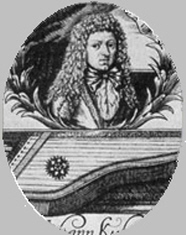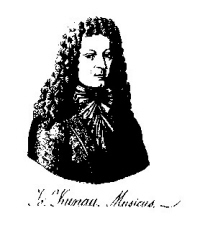|
|
Johann Kuhnau (Composer, Thomaskantor) |
|
Born: April 1660 (baptised: April 6, 1660) - Geising, Bohemia
Died: June 5, 1722 - Leipzig, Saxony, Germany |
|
Johann Kuhnau was a very remarkable musician and theorist, Kantor of Leipzig, and one of the pillars of the German school of the clavier. |
|
Life |
|
As a boy Johann Kuhnau had a lovely voice and a strong turn for music. He was put to the Kreuzschule at Dresden about 1669, where he became a Rathsdiscantist, and obtained regular instruction in music. On the breaking of his voice he worked the harder, and in addition to his music learned Italian. The plague in 1680 drove him home, but Geising was no field for his talent, and he went to Zittau and worked in the school, till the excellence of a motet which he wrote for the Rathswahl, or election of the town council, procured him the post of Kantor, with a salary on which he could study at leisure. He began by lecturing on French.
Johann Kuhnau's next move was to Leipzig, in 1682, whither his fame had preceded him, and in that city of music he cast anchor for the rest of his life. In 1684 he succeeded Kühnel as organist at St. Thomas's. In 1688 he founded a 'Collegium Musicum,' or set of concerts. At the same time he was studying law, and qualified himself for the rank of advocate. In 1700 he was made musical director of the University and of the two principal churches, and in 1701 Kantor. After this no further rise was possible. |
|
Works |
|
Johann Kuhnau left translations from Hebrew, Greek, Latin, Jtalian and French, and wrote satirical poetry of no common order. Of his works on music the following are named: Jura circa musicos ecclesiasticos (Leipzig, 1668); Der musickalische Quacksalber... in einer kurtzweiligen und angenehmen Historie... beschrieben (Dresden, 1700); Tractatus de tetrachordo; Introductio ad compositionem; and Disputatio de triade - the last three in MS.
Johann Kuhnau's secular vocal music is all lost, but many sacred works survive, mostly cantatas, but also motets on Chorals, and other sacred pieces, anticipating the style of J.S. Bach, his successor: they show lyrical vocal writing, powerful fugues and dramatic contrasts of texure which stress the rhetorical sense.
Johann Kuhnau's clavier music is his glory, and he is the greatest figure among German composers for the clavier before J.S. Bach. He published four sets of keyboard pieces, including two sets called Clavier-Übung (each with seven suites, one set in the major keys and one in the minor) and, his best-known work, the Biblical Sonatas, which describe in music, sometimes naively but with enterprising use of the harpsichord's resources, the emotional states aroused by particular stories from the Bible. He was the inventor of the sonata as a piece in several movements, not dance-tunes: - the first of which, Eine Sonata aus dem B, in three movements, is found in his Sieben Partien (Leipzig, 1695). He followed this with thirteen others - Frische Clavier-Früchte, oder sieben Sonaten (Dresden and Leipzig, 1696); Biblische Historien nebst Auslegung in sechs Sonaten - the last a curious offspring of the musician and the divine, and a very early instance of Programme music. J.S. ShedIock edited several of these quaint Bible sonatas for Novello & Co., and describes them fully in his Pianoforte Sonata. The whole set were published in the D.D.T., vol. iv., edited by K. Päsler. In addition to these he published Clavierübung aus 14 Partien . . . bestehend (Leipzig, 1689) - a collection of Suites, that is, of dance-tunes. Becker has republished two of Kuhnau's pieces in his Ausgewählte Tonstücke; and Pauer, who introduced several of them to the English public in. his chronological performances in 1862 and 1863, printed a suite in his Alte Claviermusik (Senff), and a Sonata in his ' Alte Meister (Breitkopf). |
|
J.S. Bach Connection |
|
Johann Kuhnau's successor as Thomaskantor was J.S. Bach, in 1723. Kuhnau inspired J.S. Bach in his choice of the title Clavier-Übung for four keyboard publications. He collaborated with J.S. Bach in the examination of an organ at Halle in 1716. Furthermore, Kuhnau's nephew, Johann Andreas Kuhnau, was J.S. Bach's first principal copyist of cantata parts and must have enjoyed a close association with the new Kantor. |




|
|
Source: Grove Concise Dictionary of Music (© 1994 by Oxford University Press); Grove’s Dictionary of Music and Musicians (1952 Edition, by Sir Gerorge Grove); Liner notes to the album 'Johann Kuhnau: Sacred Music'
conducted by Robert King (Hyperion, 1998, by John Butt)
Contributed by Aryeh Oron (September 2005, February 2006) |
|
Johann Kuhnau : Short Biography | Cantata BWV 142 | Motet Tristis est anima mea / Der Gerechte kömmt um | Passions-Pasticcio BWV 1088 | Johann Kuhnau & Bach | Music |
|
Thomaskantors: Thomanerchor Leipzig | Gewandhausorchester Leipzig | General Discussions: Part 1 | Part 2 |
|
Works previously attributed to J.S. Bach |
|
Cantata Uns ist ein Kind Geoboren, for Christmas Day, BWV 142 (1720?) [probable composer]
Some movements of Passions-Pasticcio BWV 1088
Motet Der Gerechte kömmt um (c1730 or c1740) [re-working by J.S. Bach] |
|
Works performed by J.S. Bach |
|
Motet Der Gerechte kömmt um, No BWV no, BC C8, reworking by J.S. Bach - performed by J.S. Bach in Leipzig c1730-35 ? |
|
Use of Chorale Melodies in his works |
|
Title |
Chorale Melody |
Year |
|
Cantata Christ lag in Todesbanden |
Christ lag in Todesbanden |
1693 at the latest |
|
A Deutsches Tedeum on the occasion of the 200th Anniversary of the Reformation in 1717 [Kuhnau's authorship still not firmly proven] |
Herr Gott, dich loben wir [The German Tedeum] |
1717 |
|
Links to other Sites |
|
Kuhnau, Johann: Biography (Sojurn)
Sleeve Notes - Kuhnau: Sacred Music (Hyperion)
HOASM: Johann Kuhnau
Johann Kuhnau (1660 - 1722) (Karadar) [German/English]
Johann Kuhnau (1660-1722) (klassiekemuziekgids) [Dutch] |
Johann Kuhnau (Encyclopædia Britannica)
Johann Kuhnau (Wikipedia)
Johann Kuhnau (Fact Monster)
Kuhnau, Johann (Columbia Encyclopedia) |
|
Bibliography |
| |
|
|